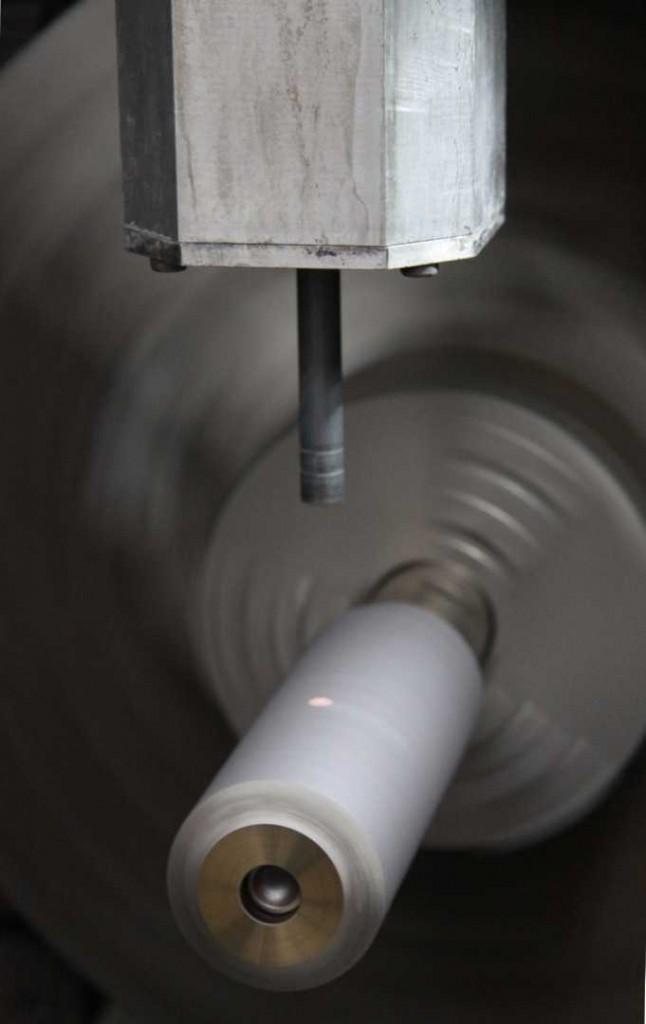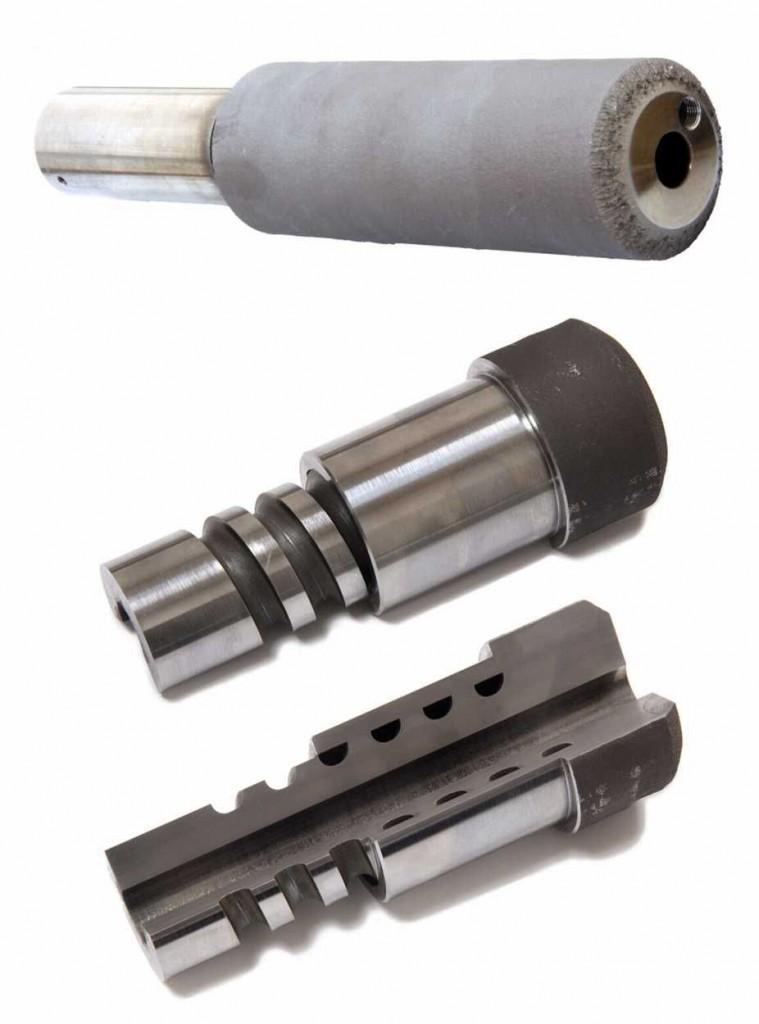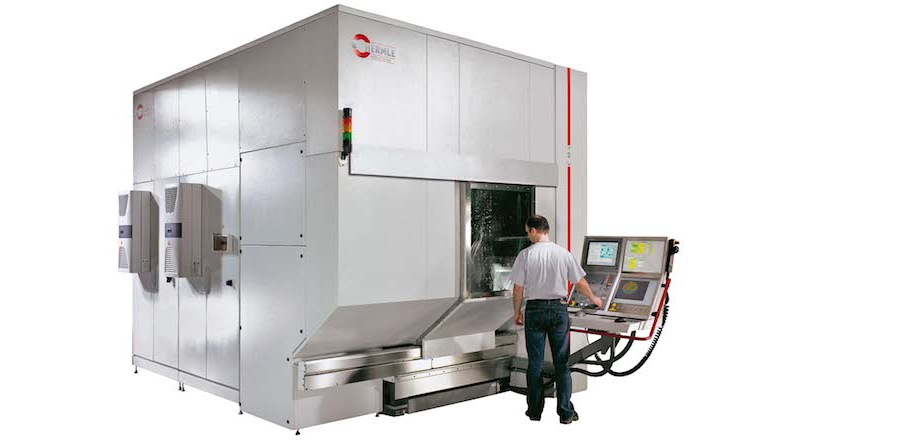Back in 1938, Berthold Hermle set up a bolt and machine screw manufacturing company in southwestern Germany. Now the firm he founded is combining additive manufacturing technology with the company’s traditional strength in subtractive methods such as machining to create a single machine tool of unparalleled capability.
MPA technology is a thermal injection process which uses metal powder and kinetic energy to meld materials to the build surfaces for large-volume components, and it can result in parts with highly complex inner geometries.
 TCT Magazine says the hybrid machine, known as the MPA 40, has a powder application nozzle mounted alongside the vertical milling spindle and a heater built into the 4th-5th axis rotary table.
TCT Magazine says the hybrid machine, known as the MPA 40, has a powder application nozzle mounted alongside the vertical milling spindle and a heater built into the 4th-5th axis rotary table.
In the process, information from a CAD file is used to direct a high-powered jet of very hot steam to propel metal powder suspended in nitrogen through a ‘de Laval’ nozzle onto a substrate at three times the speed of sound. TCT says this ‘micro-forging’ allows for up to six dissimilar metals to be layered.
In the MPA process, powder particles are accelerated within a carrier gas to high speeds and applied via a nozzle to a substrate. Back in 2007, Hermle created a coating process developed by a subsidiary, Innovaris, that they called Alchemy. That process combined a coating procedure with conventional milling.
Now in their MPA process, metal powder is applied by kinetic compacting – or micro-forging – in a process which takes metal powder, water, electricity and oxygen-reduced compressed air to build completely sealed working materials.
 What makes the process novel is the fact that the application system for the metal powder is part of a Hermle 5-axis machine. Hermle says the hybrid nature of their machine melds additive and subtractive processes and “a proven cutting technology has been extended to include the numerous possibilities of generative production.”
What makes the process novel is the fact that the application system for the metal powder is part of a Hermle 5-axis machine. Hermle says the hybrid nature of their machine melds additive and subtractive processes and “a proven cutting technology has been extended to include the numerous possibilities of generative production.”
The powder material used in the process is accelerated to very high speeds within a carrier gas and blasted through a nozzle onto the substrate at pressures of 10 GPa and temperatures up to 1000 ° C. The heat, speeds and pressure of the method leads to strong deformation of individual particles and results in a binding contact surface between them.
Hermle says the physical properties of the deposited metal layers – and transitions they go through as a result – are required to meet specific mechanical and thermal requirements and that they are optimally adjusted according to which metal powders are used.
The MPA technology is capable of dealing with materials such as hot work tool steel, stainless steel, pure copper and bronze, titanium and aluminum among others.
 The material is applied in layers only as far away as they remain accessible for later machining, and the process allows for internal cavities, channels, and undercut contours.
The material is applied in layers only as far away as they remain accessible for later machining, and the process allows for internal cavities, channels, and undercut contours.
Parts up to 550 mm in diameter, 460 mm deep and weigh up to 600 kg – with the option to use a water-soluble filler material to create internal features – can result in features like conformal cooling channels in plastic injection molds. This micro-forging means dissimilar materials like a heat-conducting copper core inside a tool steel exterior can be created.
The method is controlled with MPA-Studio, CAM software created by Hermle, which takes a layer-by-layer analysis and machining approach to building component geometry.
What sort of impact do you think this kind of hybrid technology will have on the future of manufacturing. Let us know what you think in the Hemle MPA 40 forum thread on 3DPB.com.
Subscribe to Our Email Newsletter
Stay up-to-date on all the latest news from the 3D printing industry and receive information and offers from third party vendors.
You May Also Like
3D Printing Financials: Fathom Struggles in Financial Quicksand During Critical Transition
Facing a year of key transitions and financial pressures, Fathom (Nasdaq: FTHM) has filed its annual report for 2023 with the U.S. Securities and Exchange Commission (SEC). The document outlines...
Latest Earnings Overview for Australian 3D Printing Firms Titomic and AML3D
Australian 3D printing manufacturing firms Titomic (ASX: TTT) and AML3D (ASX: AL3) reported their financial results for the period from July to December 2023, marking the first half of their...
3D Printing Webinar and Event Roundup: April 7, 2024
Webinars and events in the 3D printing industry are picking back up this week! Sea-Air-Space is coming to Maryland, and SAE International is sponsoring a 3D Systems webinar about 3D...
3D Printing Financials: Unpacking Farsoon and BLT’s 2023 Performance
In the Chinese 3D printing industry, two companies, Farsoon (SHA: 688433) and Bright Laser Technologies, or BLT (SHA: 688333), have recently unveiled their full-year earnings for 2023. Farsoon reported increases...
































